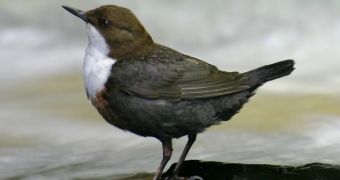According to the findings of a recent investigation, river pollution can stunt the growth of wild birds that live and nest in the proximity of contaminated watercourses. What's more, it can influence the number of female and male chicks that hatch each season, thus threatening a species' survival chances.
In a paper published in yesterday's issue of the journal Environmental Toxicology and Chemistry, researchers explain that, while monitoring Eurasian Dipper chicks in South Wales, UK, they found that those living close to urban rivers weighed less than those found in rural areas.
What's more, it was discovered that Eurasian Dippers nesting in the proximity of urban rivers hatched fewer females than birds belonging to the same species nesting close to rural rivers. On the long term, this is likely to affect breeding and drive the birds towards extinction, specialists warn.
The scientists who worked on this research project explain that, all things considered, it is likely that exposure to hormone-disrupting pollutants is to blame for these differences between the two distinct populations of Eurasian Dippers in South Wales.
It is believed that urban contaminants such as PCBs (polychlorinated biphenyls) and PBDE flame-retardant chemicals (polybrominated diphenyl ethers) that enter the birds' body when they feed on insects and fish are the ones responsible. Thus, evidence suggests that PBDEs and PCBs affect thyroid hormone levels in chicks.
“We’ve known for some time that endocrine disrupting substances can affect normal development in fish. These are some of the first data to show that PCBs and PBDEs might be causing thyroid disruption in wild birds and interfering with normal animal development,” said Dr. Christy Morrissey.
“Our findings are important in showing that pollutants are still a source of concern for the wildlife along Britain’s urban rivers despite very major recovery from the gross pollution problems of the past,” added Professor Steve Ormerod, as cited on the official website for the Cardiff University.
Researchers worry that, since wild birds serve as indicators of environmental wellbeing and natural ecosystems contamination, it might be possible that hormone-disrupting compounds present not just in rivers in South Wales, but also in other water sources in the United Kingdom, also constitute a threat to other species, humans included.
“This study highlights the importance of birds as an indicator that some pollutants still persist in our rivers at harmful levels,” said John Clark with Royal Society for the Protection of Birds.
Furthermore, “We need to work in partnership with water companies, regulators, statutory agencies and communities at a catchment scale to address those practices that continue to introduce damaging chemicals to our rivers.”

 14 DAY TRIAL //
14 DAY TRIAL //